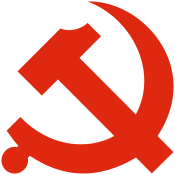More languages
More actions
Spookfessor (talk | contribs) mNo edit summary Tag: Visual edit |
Spookfessor (talk | contribs) m (changed infobox links and theory) Tag: Visual edit |
||
| Line 10: | Line 10: | ||
| think_tank = Central Policy Research Office | | think_tank = Central Policy Research Office | ||
| youth_wing = Communist Youth League of China </br> Young Pioneers of China | | youth_wing = Communist Youth League of China </br> Young Pioneers of China | ||
| political_line = Marxism–Leninism </br> Mao Zedong Thought </br> | | political_line = [[Marxism–Leninism]] </br> [[Mao Zedong Thought]] </br> [[Deng Xiaoping Theory]] </br> [[Three Represents]] </br> [[Scientific Outlook on Development]] </br> [[Xi Jinping Thought]] | ||
| website = http://cpc.people.com.cn/ | | website = http://cpc.people.com.cn/ | ||
}}{{Communist Parties}} | }}{{Communist Parties}} | ||
Revision as of 15:13, 11 June 2021
Communist Party of China 中国共产党 | |
|---|---|
 | |
| Abbreviation | CPC |
| General Secretary | Xi Jinping |
| Founded | 23 July, 1921 |
| Newspaper | People's Daily |
| Think tank | Central Policy Research Office |
| Youth wing | Communist Youth League of China Young Pioneers of China |
| Website | |
| http://cpc.people.com.cn/ | |
| Part of a series on |
| Communist parties |
|---|
The Communist Party of China (CPC) (in Western media it is typically written as CCP, or Chinese Communist Party) is the vanguard of both of the Chinese working class and of the Chinese nation. It is guided by its ideology which is a practical application of Marxism-Leninism to the specific conditions of China. Among these ideological developments is Socialism with Chinese characteristics which emphasizes the development of China's advanced productive forces, the orientation of China's advanced culture and the fundamental interests of the overwhelming majority of the Chinese people. The realization of communism is the highest ideal and ultimate goal of the Party. [1]
History
The Communist Party of China was founded on July 23, 1921, heavily influenced by the events of the May Fourth Movement and the October Revolution.[2] After many years of civil war in which the CPC achieved total victory in mainland China and most of the coastal islands, led the People's Liberation Army to defeat the National Army of the Republic of China, and forced the Republic of China into a military coup.
The government of the Republic of China retreated to Taiwan. Mao Zedong established the People's Republic of China in Beijing in 1949, the only ruling party in the PRC leading the Workers' and Peasants' Alliance and the United Front on behalf of the working class and exercising the People's Democratic Dictatorship in mainland China since October 1949.
Demographics
In 2020, The Communist Party of China is about 91,914,000 members large or about 6.57% of their population. In 2017, about 26.7% of members are women.[3] In 2015, roughly 30% are farmers, herdsmen or fishermen, 25% white collar workers, 18% retirees, 8% government employees.[4]
On July 2, 2001, Jiang Zemin allowed the possibility of membership to be extended to the Bourgeoisie.[5]
References
- ↑ The constitution of the Communist Party of China
- ↑ Hu Qiaomu. Thirty years of the Communist Party of China (Beijing: Foreign Languages Press)
- ↑ https://news.sina.com.cn/c/2018-06-30/doc-ihespqrx6865303.shtml
- ↑ https://daily.jstor.org/communist-party-of-china/
- ↑ https://www.washingtonpost.com/archive/politics/2001/07/02/china-allows-its-capitalists-to-join-party/98c51d3e-590c-4f1b-a52a-132b3def1281/
